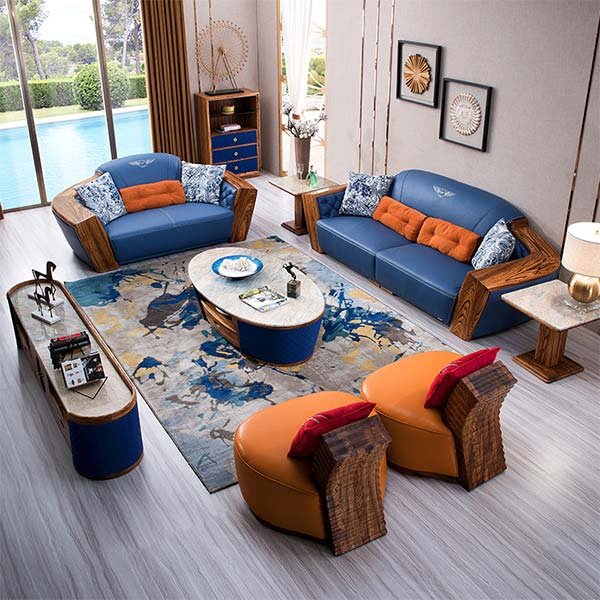“Wooden Furniture: Building a Sustainable Future, One Piece at a Time”
Benefits of using sustainably sourced wood for furniture production
Benefits of using sustainably sourced wood for furniture production
Wooden furniture has been a staple in homes and offices for centuries. Its timeless beauty and durability make it a popular choice among consumers. However, with the growing concern for the environment, it is important to consider the impact of furniture production on our planet. This is where sustainably sourced wood comes into play.
Sustainably sourced wood refers to wood that is harvested in a way that ensures the long-term health and viability of the forests from which it is obtained. This means that the trees are carefully selected for harvesting, and new trees are planted to replace the ones that are cut down. By using sustainably sourced wood for furniture production, we can help protect our forests and ensure their survival for future generations.
One of the key benefits of using sustainably sourced wood for furniture production is its positive impact on the environment. Unlike other materials such as plastic or metal, wood is a renewable resource. Trees can be replanted and grown again, making it a sustainable choice. Additionally, sustainably managed forests act as carbon sinks, absorbing carbon dioxide from the atmosphere and helping to mitigate climate change.
Another benefit of using sustainably sourced wood is its contribution to local economies. Many communities around the world rely on the forestry industry for employment and economic growth. By supporting sustainably managed forests, we can help create jobs and stimulate local economies. This not only benefits the people living in these communities but also helps to reduce poverty and improve living standards.
In addition to its environmental and economic benefits, sustainably sourced wood also offers aesthetic advantages. Wood has a natural warmth and beauty that cannot be replicated by synthetic materials. It adds a touch of elegance and sophistication to any space, making it a popular choice among interior designers and homeowners alike. Furthermore, wooden furniture can be easily repaired and refurbished, extending its lifespan and reducing waste.
As consumers become more conscious of the environmental impact of their purchasing decisions, the demand for sustainably sourced wood furniture is on the rise. Many furniture manufacturers and retailers are now offering eco-friendly options to cater to this growing market. This trend not only benefits the environment but also allows consumers to make a positive impact through their choices.
In conclusion, using sustainably sourced wood for furniture production offers numerous benefits. It helps protect our forests, mitigates climate change, supports local economies, and provides aesthetic advantages. As the demand for eco-friendly furniture continues to grow, it is important for consumers to make informed choices and support sustainable practices. By opting for wooden furniture made from sustainably sourced wood, we can contribute to a more sustainable future for generations to come.
Innovative techniques for reducing waste in wooden furniture manufacturing
Innovative techniques for reducing waste in wooden furniture manufacturing
Wooden furniture has long been a popular choice for homeowners and businesses alike. Its timeless beauty and durability make it a sought-after material for creating functional and aesthetically pleasing pieces. However, the manufacturing process of wooden furniture can have a significant impact on the environment, particularly in terms of waste generation. Fortunately, there are innovative techniques that can be employed to reduce waste and promote sustainability in the industry.
One such technique is the use of computer-aided design (CAD) software. This technology allows manufacturers to create detailed digital models of furniture pieces before they are produced. By doing so, they can optimize the use of raw materials and minimize waste. CAD software also enables manufacturers to experiment with different designs and configurations, ensuring that each piece is crafted with precision and efficiency.
Another innovative technique is the implementation of lean manufacturing principles. Lean manufacturing focuses on eliminating waste and maximizing value for the customer. In the context of wooden furniture manufacturing, this means streamlining production processes to minimize material waste, energy consumption, and time inefficiencies. By adopting lean manufacturing principles, manufacturers can reduce their environmental footprint while also improving the quality and affordability of their products.
Furthermore, the concept of circular economy has gained traction in recent years as a means of promoting sustainability in various industries, including furniture manufacturing. In a circular economy, resources are kept in use for as long as possible, and waste is minimized through recycling and repurposing. In the context of wooden furniture, this can involve using reclaimed or recycled wood, as well as designing products that can be easily disassembled and recycled at the end of their life cycle.
Additionally, advancements in technology have paved the way for the use of sustainable materials in wooden furniture manufacturing. For instance, bamboo has emerged as a popular alternative to traditional hardwoods due to its rapid growth and renewability. Bamboo is not only durable and aesthetically pleasing, but it also has a significantly lower environmental impact compared to other types of wood. Similarly, manufacturers are exploring the use of engineered wood products, such as plywood and particleboard, which are made from recycled wood fibers and offer a more sustainable option.
In conclusion, the wooden furniture industry has made significant strides in reducing waste and promoting sustainability through innovative techniques. The use of CAD software, lean manufacturing principles, and the adoption of circular economy concepts have all contributed to a more environmentally friendly manufacturing process. Additionally, the exploration of sustainable materials, such as bamboo and engineered wood products, has opened up new possibilities for creating eco-friendly furniture. By embracing these techniques and trends, the industry is moving towards a more sustainable future, where wooden furniture can be enjoyed without compromising the health of our planet.
The role of wooden furniture in promoting a circular economy
Wooden furniture plays a crucial role in promoting a circular economy, which is essential for building a sustainable future. The concept of a circular economy revolves around reducing waste, reusing materials, and recycling products to minimize the negative impact on the environment. In this article, we will explore how wooden furniture contributes to a sustainable future by examining its benefits and discussing the current trends in the industry.
One of the primary reasons why wooden furniture is considered sustainable is because wood is a renewable resource. Unlike other materials like plastic or metal, wood can be harvested from forests and replanted for future use. This ensures that the supply of wood is not depleted and allows for the continuous production of wooden furniture without causing harm to the environment.
Furthermore, wooden furniture has a long lifespan, which contributes to its sustainability. High-quality wooden furniture can last for generations if properly cared for. This means that fewer resources are needed to produce new furniture, reducing the overall environmental impact. Additionally, wooden furniture can be repaired and refurbished, further extending its lifespan and reducing waste.
In recent years, there has been a growing trend towards using reclaimed wood in furniture production. Reclaimed wood refers to wood that has been salvaged from old buildings, barns, or other sources and repurposed for furniture making. This not only gives the wood a second life but also reduces the demand for new timber, thus preserving forests and promoting sustainability.
Another trend in the wooden furniture industry is the use of eco-friendly finishes and coatings. Traditional finishes often contain harmful chemicals that can be released into the environment during production and use. However, many manufacturers are now opting for natural and non-toxic finishes that are safer for both the environment and human health. These eco-friendly finishes not only contribute to a sustainable future but also enhance the natural beauty of the wood.
In addition to the materials used, the manufacturing process of wooden furniture also plays a role in its sustainability. Many manufacturers are adopting energy-efficient practices and using renewable energy sources to power their production facilities. This reduces the carbon footprint associated with the manufacturing process and contributes to a greener and more sustainable industry.
Furthermore, wooden furniture can be easily disassembled and recycled at the end of its life. Unlike furniture made from composite materials, wooden furniture can be broken down into its individual components and recycled or repurposed. This reduces the amount of waste sent to landfills and promotes a circular economy where materials are continuously reused.
In conclusion, wooden furniture plays a significant role in promoting a sustainable future by contributing to a circular economy. Its use of renewable resources, long lifespan, and potential for recycling make it an environmentally friendly choice. The industry is also embracing trends such as using reclaimed wood and eco-friendly finishes, further enhancing its sustainability. By choosing wooden furniture, consumers can make a positive impact on the environment and contribute to a more sustainable future.
Заключение
Заключение: Деревянная мебель играет важную роль в создании устойчивого будущего. Она является экологически дружественным материалом, так как дерево является возобновляемым ресурсом. Кроме того, деревянная мебель имеет долгий срок службы и может быть переработана или восстановлена, что способствует уменьшению отходов и потребления новых материалов. Также стоит отметить, что деревянная мебель создает природную и теплую атмосферу в помещении, что способствует комфорту и благополучию людей. В целом, использование деревянной мебели способствует устойчивому развитию и содействует сохранению окружающей среды.



